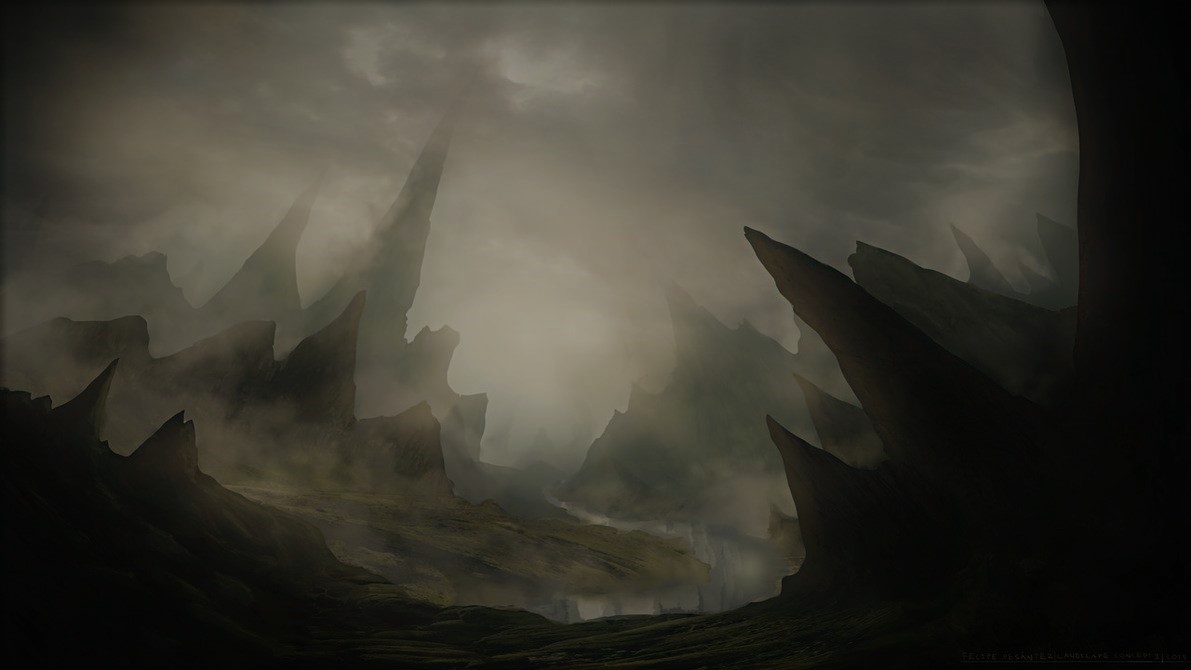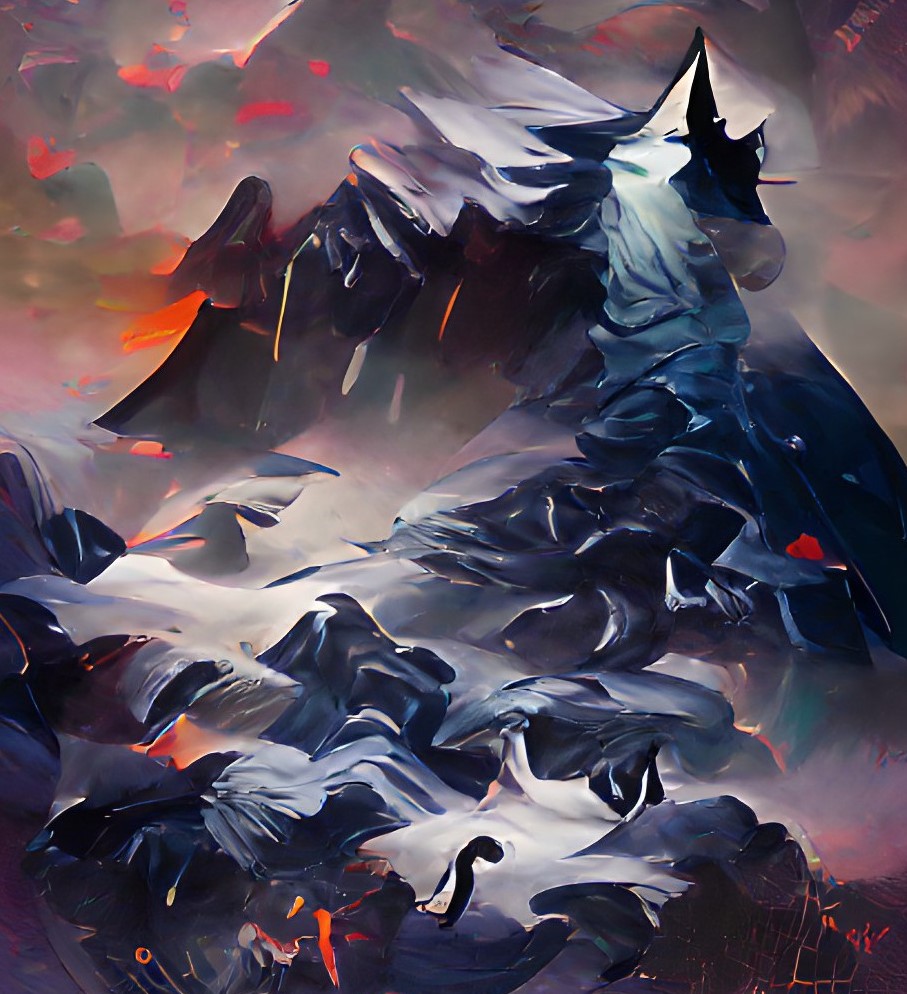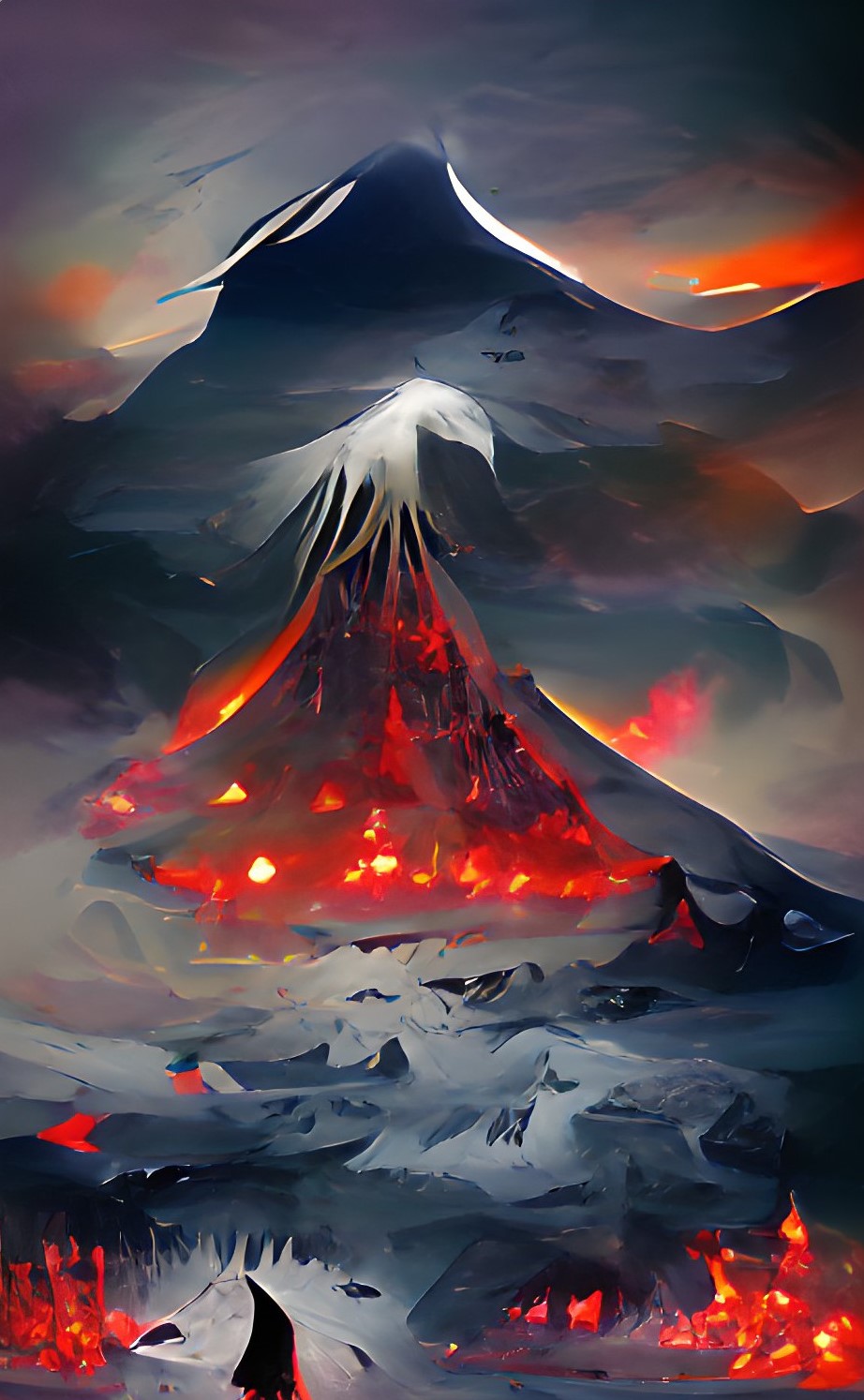Tukhamu Magas
Description
Tukhamu Magas, also colloquially known as the Ashlands, is a rugged and mountainous highland region to the northwest of the Swamps of Vörövisz and the west of the Eltórián Bonelands. Very little of the region falls below 1500m, while some of its peaks reach up to 4500m at the most extreme. It covers a very large area, and travel through the region is only possible through the many treacherous mountain passes. This has had a curious effect on the spread of divinities throughout the region. Whereas in other regions many came into conflict early on and conquered or were conquered, this has not been the case for the Ashlands. It is for this reason that many of the minor divinities survived for an extended period and a total of five were able to attain the status of major divinity despite the limited population here. They have been able to slowly grow their influence without fear of being squashed by a larger player, but as a consequence they are slightly weaker than the major divinities of the neighboring regions. They are also starting to intrude on each other's territory, and conflict between the five seems inevitable.Ash and Wind
This region is basically a very large volcanic belt consisting of numerous mountains, volcanoes and cinder cones, and it has calmed down only in recent centuries. At least in intensity that is, because in terms of frequency it is still a very geologically active area with frequent eruptions of ash and tephra. Particularly the cinder cones frequently expulse ash. Seeing as it is located on a toroid planet, the weather tends to extremes, and in this elevated region that means a temperate climate but harsh winds especially during storm season. These displace the ashes and spread them out over a larger area, which gives the region its nickname, but it also leads to a slightly toxic environment. There is pretty much always some ash floating around, and people usually cover their mouth with a scarf or such to prevent accidental inhalation. Bodies of water are also frequently polluted by the ashes, which means that the people here rely on rainwater and hand pumps that draw up groundwater for much of their drinking water. Rivers can still provide drinkable water at times as the ash quickly flows out, and there are a great many rivers that course through the mountainous valleys. Occasionally the geological activity, harsh weather and many rivers will all together cause catastrophes such as landslides or mudflows. The volcanic activity has also lead to a slightly elevated ground temperature, which means there is little to no snow in the region, despite the elevation. It does however stretch into some icefields in the far northwest, but it is contested whether that can even be considered part of this region. But it is not just the environment that presents danger, but also the inhabitants. Among the ashes hide fiendish creatures made of smoke that choke out the living for their own sick amusement. In the mountains lurk alluring harpies waiting to dash their prey on the rocks before picking them apart. Closer to the volcanoes and cinder cones elemental creatures can be found, from small cinder swarms to mischievous mephits, and closest to the geological activity full-blown elementals or even powerful dzsinn can be found.Overview
Themes and Keywords
Volcanic activity, elementals, storms, chthonic cults, lost ruins, isolation.Common Fauna
Fish (trout, lamprey), harpies, elementals (e.g. füsters), vampire finches, thornback raptors, cockatrices, urúsz, magmapoda, ash cougars, hyenas. Brief Descriptions.Harpía. Man-eaters that resemble women with wings and taloned feet.
Füsters. Smoke elementals that choke out their victims from the inside.
Thornback Raptors. Raptor-like predators covered in spikes to dissuade larger predators.
Urúsz. Large ungulates, beasts of burden similar to cows but with a shaggy coat of fur and a grouping of horns near the head.
Magmapoda. Large snail-like creatures that can secrete an insulating mucus to protect against heat, and can spray together two chemicals that ignite in open air as a defense mechanism.
Ash Cougars. Large, grey-furred felines that are well-camouflaged in this environment.
Unique Flora
Fényhozó Moss. A type of blue-green moss mostly found in caves around the Nagyéses Falls. It is bioluminescent and creates a vague bluish glow.Kőrisvirág. Also called ashflower, this grey-colored flower seems to magically drain color from its surroundings. At first it is a vaguely noticeable dulling, but in time it turns the entire area as grey as itself, growing taller all the while.
Sártuz. Sometimes nicknamed Dragon's Breath for its spiciness, the leaves of this plant are an indispensable part of sárbolszégian cuisine. It is difficult to harvest properly, and when cut releases an invasive smell similar to burnt rubber.
Szükorica. A corn-like plant whose starch forms a gummy mixture when mixed with water, which in turn forms into a slime that will harden over time and is used as candy. For some unknown reason the plant attracts many local dangerous wildlife such as bears and thornback raptors.
Points of Radiance
The difficulties in traversing this region have allowed many of the divinities and their associated Points of Radiance to grow independently without much interference from each other. This is the most important reason as to why so many divinities here have attained the status of major divinity, even if they are weaker than some of their counterparts from other regions. The five cities associated with the major divinities of this region are as follows:Béhegy Kolostor
The smallest of the five, this mountain monastery lies on the peak of the Égboltnyitás, one of the tallest mountains in the region. The nearly thousand inhabitants practice a cycle of self-isolation and communal living and debate to reach enlightenment through a shared understanding. The spring struck by Béhegy supplies them with irrigation for their terrace farms that keep the monastery independently sustainable.Harczikötö
Hidden behind one of the waterfalls of the Nagyéses Falls, lies the port city dedicated to the War divinity Harczeg. A martial culture through and through, most people here aspire to become a húszar or warrior, and take part in the raiding parties that set out along the river network of the region. They leave alone the peaceful béhegyans, and their allies the helorszégians, but everyone else is fair game for these highly disciplined and efficient warriors.Helorszég
The City of a Thousand Scaffolds is a marble bastion that surrounds the stone throne of Helőre. Built atop an ancient mine system from a lost civilization, this circular city openly displays its strict law system in the form of public displays of punishment. Strict but fair, that is the motto and the people live by it, believing that it leads to the greatest good. As part of this, there is no stigma to having served a sentence, only to not having learned from it. Those who redeem themselves are celebrated, but working towards that redemption can be tough when you have just been humiliated.Sárbolszég
Passion is the lifeblood of the city dedicated to the Deceiver Sárbolc. He who tricked the Elden Wyrm Csártuzra to provide his people with dragon-fire to forge weapons that allowed them to fend off the dangerous smoke fiends known as füsters. The attitude of the sárbolszégian can be most easily summarized in the idiom 'follow your heart'. They truly believe that to chase your passions, your most heartfelt desires, is the only correct way to live. Be true to yourself and you will live your best life, even if it is short, that is how it goes.Szilavár
The mercantile center of the region is none other than the city of Szilavár, dedicated to the divinity Szilád. This city, nestled at halfway height of the Széleredete, the Many-Spire Mountain, is a melting pot where nearly anything the region has to offer can be bought or sold, even people. The natives of the Ten-Spire Towns are an ephemereal people, truly fitting of the comparison 'like the wind'. The Windreaders have developed such precise control over wind magic that they are capable of ferrying people up and down between the city and the spire towns in simple wooden barges. It is a city of personal freedom and individualism, but also a certain amount of lawlessness.Minor Points of Radiance
Smaller divinities tend to either be consumed by the larger ones, or their hallows are overrun by creatures of all kinds and they are never discovered. Many of the minor divinities here were fairly isolated from each other due to the terrain, but now they are drawing the notice of the newly ascended major divinities. They have to either make treaties or risk becoming a target for expansion. Some of the more notable minor Points of Radiance (and their related divinities) in the region are listed below.- Maszlynőszég: In a valley near Sárbolszég lies a small town dedicated to the minor divinity Maszlynője, also known as the Queen of Masks. She is a divinity of Death, representing the aspect of a Peaceful Passing. She is a compassionate, motherly divinity who greets her worshipers in the form they most desire to see upon their passing. For whatever reason, Sárbolc seems to respect and protect her, and she and her village have been made his vassal rather than being conquered.
- Bíkaldoszég: On the slopes of the hill between Helorszég and Fort Közeltrón lies the village of Bíkaldoszég, which is vassal to Helorszég. It is dedicated to the minor Life divinity Bíkaldozat who represents the aspect of Sacrifice. His followers pray for favorable events and light repercussions for their mistakes. Interestingly they do not make offers directly to their god, but instead he observes the sacrifices they make for others in their life, and rewards them accordingly when he deems the time right. Its people are sometimes considered a little strange, and overly helpful to the point of being importunate.
- Megabadí Nomads: North of the Öroklang forests that were burned out by Sárbolc, lives a nomadic tribe that constantly move in and out of their god's territory to hunt, forage and survive. Megabadí is a weak divinity, having once been tricked and tortured by Sárbolc, and so he cannot venture far. He is capable of only protecting a small area, not large enough to hold all his tribes. But it is still a safe stop for them, and their home. Megabadí himself is a minor Chaos divinity who represents the oppressed breaking free, having taken on the aspect of Liberation. As an example of this, the tribes of his followers contain many run-away slaves from Szilavár.
Notable Locations
These mountainous valleys are often isolated from each other, birthing isolated communities of people and creatures not held back by many other predators. Thus one valley may be full of large animals, while a nearby mountaintop is brimming with elementals. Often such creatures are drawn to unique geographical features that allow them shelter, a vantage point, or for some more esoteric reasons. Examples of such locations include:Fort Közeltrón
As Helőre's territory expanded, a small hill fort was built on one of the nearby peaks to overlook a grouping of mountain passes important for travel. But the fort also happened to be located close to the Szembarlang, and was the subject of constant raids by the Cult of Eyes. On one unfortunate day it was overrun by the cult, who pillaged and destroyed most of it. The cult was pushed out again later, but the fort lay ruined and was quickly abandoned again and the cult swooped back in. It is still the battleground of continuous scuffles between the helorszégian soldiers and the cult.The Maw
The Maw, also called the Harpíaszáj, is a cliffside overlooking a steep drop with sharp, teeth-like rocks at the bottom. It is said that this is where the first harpy jumped down and was transformed. Either way, it is true that many harpies have built their aeries into the canyon's cliff here. They try to lure people over the edge with their song, dashing them upon the rocks after which they cannibalize the corpses. Those who shake off the song in time may not be any luckier, as being alive for the torment harpies inflict on them if they are caught is considerably worse.Örökláng Forest
The öröklang was once a vibrant forest to the northeast of Szilavár, but in a petty conflict between Szilád and Sárbolc it was burned out by the latter. Where it was once filled with animals and plants, now there are only blackened trees and elemental creatures that are naturally drawn to the flames that still burn in some places. Snakes and salamanders of living flame stalk around, looking to preserve the few flames that still burn in this forest, considering them to be an elemental force of their own.Szembarlang
Mount Szembarlang is a currently inactive volcano located close to Helorszég, and surrounded by mystery. Since long ago there have been reports of strange one-eyed, stalking giants coming up from deep within the volcano's belly. Over time a sort of cult sprang up nearby, revering the supposed conclave of these creatures, and in particular a creature they called the 'Lord of Eyes', he who sees all. While reports of the creatures are still sparse, the cultists and other beasts accompanying them have been clearly reported. And some of these reports have been disturbing, talking of strange alterations to the bodily form, and near-hallucinogenic experiences caused by being in their vicinity.
Alternative Name(s)
The Ashlands, Land of Ash and Wind
Included Organizations
Related Myths
Remove these ads. Join the Worldbuilders Guild





Comments